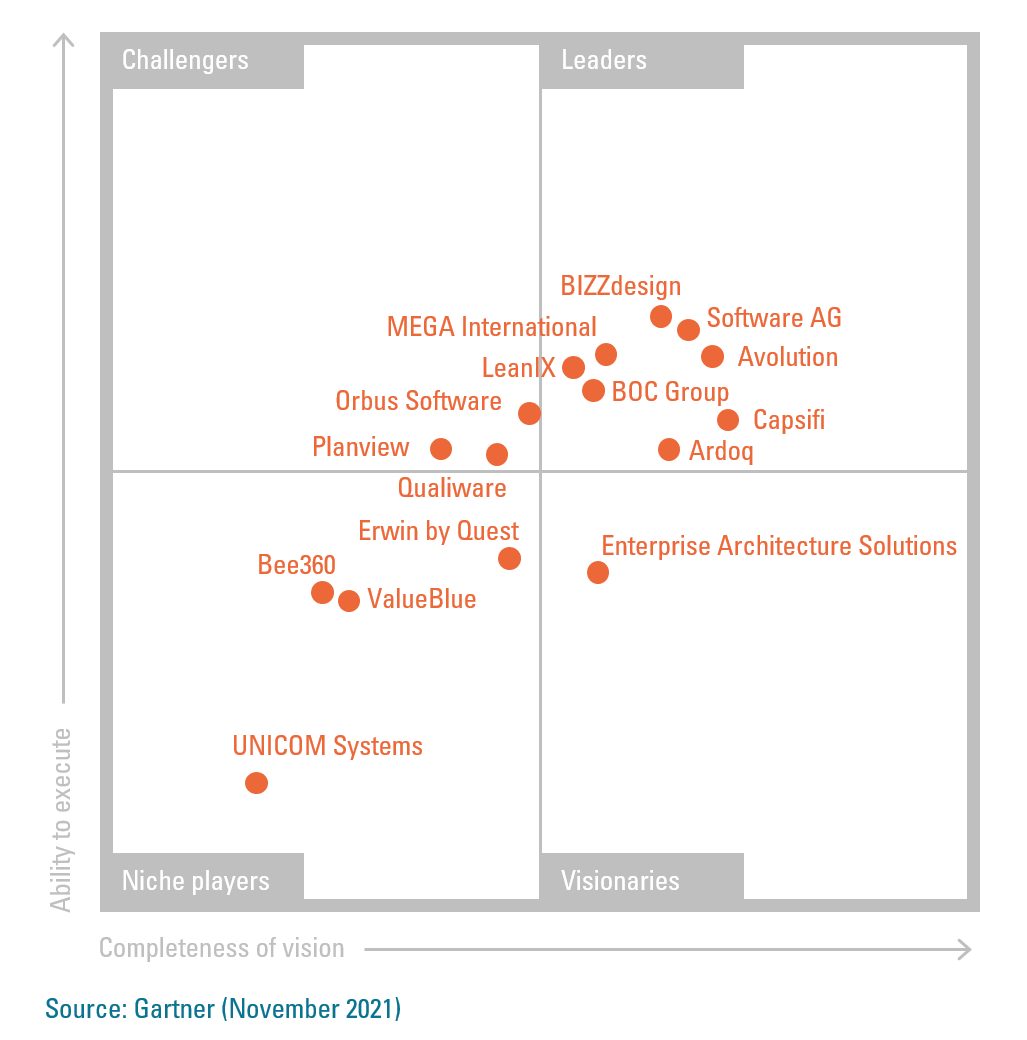
Enterprise Architecture Tools: it’s in the quadrant
In late 2021, Gartner published its Magic Quadrant for Enterprise Architecture Tools. It lists the highest-performing vendors with focus and momentum in the market for EA tools. Although the market for Enterprise Architecture tools is still young and in full development the report is a great resource. But not many take the time to look beyond the famous two-by-two-matrix. Luckily for you, we did read the entire report and we found three key takeaways that you would miss out on if you just focus on the quadrant.
“Architecture is a hazardous mixture of omnipotence and impotence.” ― Rem Koolhaas
What is Enterprise Architecture Tooling
Whereas this quote regarding the world of physical architecture has been around for decades, it easily holds true for the world of Enterprise Architecture. Enterprise Architecture (EA) is defined as “the structure of components, their inter-relationships, and the principles and guidelines governing their design and evolution over time,” capturing elements of the business, data, application, and technology architecture. It helps organizations optimize their (often) legacy IT landscapes into an integrated and sustainable environment, including benefits in the domains of efficient business and IT operations and effective Digital Transformation.
EA is a relatively young field of research and expertise sitting between the realms of business and IT, with its strategic relevance and increasing popularity supported by Gartner’s research that reports a 15-30% growth of the market for EA tooling over the last year alone. EA tooling helps organizations in assessing the need for and impact of changes in their architecture. Among other features, EA tools serve as a repository (a metamodel) of objects and (meta)data that helps in the modeling of structures and processes and facilitates further analysis and presentation.
To help you navigate the world of omnipotence and impotence of EA tools, we have taken a close look at Gartner’s Magic Quadrant for Enterprise Architecture tools and we are happy to share our thoughts and findings through this blog.
Gartner’s Magic Quadrant for Enterprise Architecture tools
In late 2021, Gartner published its Magic Quadrant for Enterprise Architecture Tools. It lists the highest performing vendors with focus and momentum in the market for EA tools and ranks them among the axes of ability to execute and completeness of vision.
The ability to execute is determined by factoring in criteria regarding the product itself (core and optional capabilities), sales execution, and also items such as the tool’s track record and customer experience.
The completeness of vision has been assessed by analyzing the vendor’s market understanding (trends that the vendor expects, the various use cases for the tool, the vendor’s expectations regarding the evolvements of the EA tool marketing), its offering strategy, its innovation capabilities, and its industry strategy. This yields a quadrant with Leaders, Challengers (runner-ups with leading potential), Visionaries (innovators in the market), and Niche players (operating in a subsegment of the market).
Gartner’s research included sixteen EA tools, of which eight have been qualified as leaders, three as challengers, one as a visionary, and four as niche players. The quadrant itself can be found below and the full report can be found here.

Three hidden secrets in the Magic Quadrant
All tool’s strengths and cautions aside, we have three takeaways to help you make sense of what can be read between the lines.
1. The future lies in collaboration
The best EA tools do what EA does best: bridging the gap between business and IT. EA tooling has a huge potential in converting data to information and information to insights, while visualizing all input along the way. This data may involve business strategies and scenarios, product, market, and competitor data just as easy as it may involve data regarding the technologies and software supporting the business, whereas its presentation and graphical features help in telling the story to not only IT or EA stakeholders but to the business as a whole. It’s this symbiosis between business and IT, between the current state and potential future state, and the short-term and long-term objectives that allow the Leaders to dominate the market – and the other tools to become a Leader.
2. All Leaders are invested in Machine Learning
After evaluating all tool’s strengths and cautions, the one thing that stands out is that all Leaders invest in Machine Learning (ML). ML has either already been captured in the strengths of their current offerings or is listed in their product roadmap, but ML will find its way in their EA tooling in one way or another. Just like all other ML applications, one can ask how ML can help in strategic decision-making. Exactly this is what ML in EA applications seems to focus on: how can ML aid decision making, and how can ML amplify the human talent in understanding the complexities an IT landscape holds when trying to change or stabilize it?
3. Full potential held hostage by current market mechanisms
Although the market for EA tools is still young and in full development, unfortunately, it seems that virtually all players have one thing in common: their complex and potentially untransparent pricing strategies. In a response that is as understandable as it is regrettable, organizations adopting EA tooling may limit its use to a selected group of users. Even though it makes perfect sense as an attempt to maintain a grip on the costs of using an EA tool, this, unfortunately, tends to limit EA tool usership to the IT department… and that exactly is what EA is not about in the first place.
The future of EA tools
With respect to the third item, we expect to see more mature pricing schemes as the market matures as a whole, and we are curious to see how the other factors will continue to influence the EA tooling market. At the end of the day, EA is all about creating and maintaining a sustainable relationship between your IT assets and business objectives – and we believe that EA tooling will help in professionalizing and democratizing just that.
We will continue to keep an eye on the available tooling and the way they are developing. Want to stay tuned, or want to further discuss the world of EA, the tools of the trade, or your own enterprise architecture? Schedule an introductory meeting with us here or leave your details below and we will get back to you.
Thank you for your message!
We will get back to you as soon as possible.
Cases & Solutions

Our top 7 ERP vendors for 2020
A new ERP? Let’s say you need to figure out what ERP-system is the best fit for your organization. That shouldn’t be hard, right? I’m afraid I’ve got some bad news for you. There are more than 250 systems to go over! Choosing the right one can be hard; that’s why we created a list with the top 7 ERP vendors of 2020 for you.

Three tips to help your ERP selection
Selecting the right ERP is something you don’t do every day. To help you get started with your ERP selection we selected three tips.